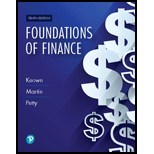
(Residual dividend policy) FarmCo, Inc. follows a policy of paying out cash dividends equal to the residual amount that remains after funding 40 percent of its planned capital expenditures. The firm tries to maintain a 40 percent debt and 60 percent equity capital structure and does not plan on issuing more stock in the coming year. FarmCo’s CFO has estimated that the firm will earn $12 million in the current year.
- a. If the firm maintains its target financing mix and does not issue any equity next year, what is the most it could spend on capital expenditures next year given its earnings estimate?
- b. If FarmCo’s capital budget for next year is $10 million, how much will the firm pay in dividends and what is the resulting dividend payout percentage?
Want to see the full answer?
Check out a sample textbook solution
Chapter 13 Solutions
Pearson eText Foundations of Finance -- Instant Access (Pearson+)
Additional Business Textbook Solutions
MARKETING:REAL PEOPLE,REAL CHOICES
Accounting For Governmental & Nonprofit Entities
Auditing And Assurance Services
Operations Management
Financial Accounting: Tools for Business Decision Making, 8th Edition
Principles Of Taxation For Business And Investment Planning 2020 Edition
 EBK CONTEMPORARY FINANCIAL MANAGEMENTFinanceISBN:9781337514835Author:MOYERPublisher:CENGAGE LEARNING - CONSIGNMENT
EBK CONTEMPORARY FINANCIAL MANAGEMENTFinanceISBN:9781337514835Author:MOYERPublisher:CENGAGE LEARNING - CONSIGNMENT
